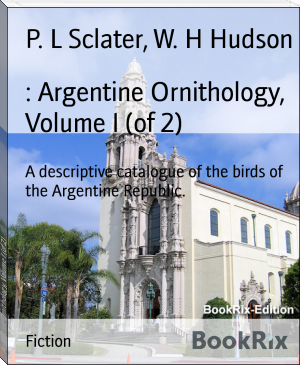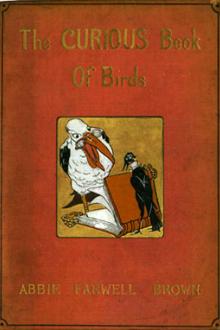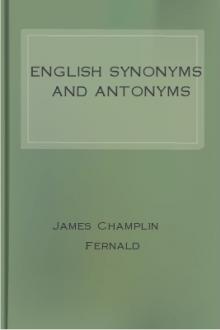: Argentine Ornithology, Volume I (of 2), P. L Sclater, W. H Hudson [best authors to read txt] 📗

- Author: P. L Sclater, W. H Hudson
Book online «: Argentine Ornithology, Volume I (of 2), P. L Sclater, W. H Hudson [best authors to read txt] 📗». Author P. L Sclater, W. H Hudson
vertically, with tail raised, and rapidly beating its wings, and looking
while ascending in this way more like a butterfly than a bird; and when
it has reached a height of ten or twelve yards, it drops obliquely to
the earth and perches on a stalk." He adds that the males are solitary,
but several females are sometimes seen near together, and that the
females are greatly in excess of the males.
123. ALECTRURUS RISORIUS (Vieill.). (STRANGE-TAILED TYRANT.)
+Alectrurus guira-yetapa+, _Scl. et Salv. Nomencl._ p. 43; _Durnford,
Ibis_, 1878, p. 60 (Buenos Ayres). +Alectrurus risorius+,
_Barrows, Bull. Nutt. Orn. Cl._ viii. p. 140 (Entrerios).
+Alectrurus psalurus+, _Burm. La-Plata Reise_, ii. p. 457 (S.
Luis).
_Description._--Above black, rump grey; front varied with white;
wings black, scapularies, outer margins of wing-feathers and coverts
white; tail black, two outer rectrices much elongated, denuded at
the base, with a broad inner and no outer vane; below white, broad
band across the breast black; throat in the breeding-season bare of
feathers and of a bright orange; bill yellowish; feet black: whole
length 11·0 inches, wings 3·0; tail, outer rectrices 8·0, middle
2·0. _Female_: above brown, wings varied with white; beneath white;
breast-band pale brown; tail with the two outer rectrices slightly
elongated and denuded, terminated with spatulations on the inner
vane.
_Hab._ S. Brazil, Paraguay, Uruguay, and Argentine Republic.
Azara named this species _Cola estraña_ (Strange-tail), but mentions
incidentally that its Guarani name is 'guira-yetapá' (Scissor-tail), a
term which the Indians apply indiscriminately to several species having
the same sort of tail.
The Guira-yetapá is a very curious little bird, with a black, white, and
grey plumage and the beak of a true Tyrant; but it differs from all its
congeners in having the skin of the chin, throat, and sides of the head
bare of feathers, and these parts in the breeding-season are a bright
orange colour. It is a feeble flier, its wings being very short, while
the two outer tail-feathers are abnormally long and peculiar in form.
Mr. Barrows says:--"The remarkable condition of the outer pair of
tail-feathers is interesting. In the male these two feathers reach a
length of nearly ten inches, the rest of the tail being about three
inches in length. The vane on the _inner_ side of each is wanting for
the first two inches, and then suddenly develops to a width of nearly
two inches, which it maintains almost to the tip, when it gradually
narrows. The vane on the _outer_ side of the shaft is only about
one-quarter of an inch wide, and is folded so tightly against the shaft
that it is quite inconspicuous. In the only two males of this species
which I have seen flying, these long feathers seemed to be carried
folded together _beneath_ the rest of the tail, and stretching out
behind like a rudder or steering-oar, their vanes at right angles to
the plane of the rest of the tail."
Mr. Gibson gives a different account, and says the flight is singularly
feeble, resembling the fluttering passage of a butterfly through the
air, while the tail streams out behind.
It inhabits Paraguay, Uruguay, and the eastern portion of the Argentine
Republic, ranging as far south as the pampas in the neighbourhood of
Patagonia. It is usually seen singly or in pairs; Azara says he saw a
flock of thirty individuals, but as they were all _females_, it may be
that in this species, as in _Lichenops perspicillata_, the females are
sometimes gregarious, and the males always solitary. It frequents open
places, such as the borders of marshes, or plains covered with tall
grasses, and perches in a conspicuous place, from which it darts at
passing insects like a Flycatcher.
Mr. Gibson found its nest on the ground amongst herbage, and describes
it as a neat structure of dried grass, containing three white eggs with
a faint cream-coloured tinge.
124. CYBERNETES YETAPA (Vieill.). (YETAPA TYRANT.)
+Cybernetes yetapa+, _Scl. et Salv. Nomencl._ p. 43; _White, P. Z. S._
1882, p. 604 (Itapua, Misiones).
_Description._--Above hoary grey, with lineiform blackish
shaft-stripes; wings black, with large chestnut-brown patch
occupying the outer webs of the inner primaries; tail of twelve much
graduated feathers, black; outer web of external rectrices white;
beneath same as above, but rather paler; throat and crissum white;
patch on each side of the neck, and collar across the neck dark
chestnut-brown; under wing-coverts and inner webs of wing-feathers
white; bill pale brown; feet black: whole length 16·0 inches, wing
5·0; tail, extreme rectrix 12·5, middle 2·6. _Female_ similar, but
less bright.
_Hab._ S.E. Brazil, Paraguay, Bolivia, and Northern Argentina.
Azara found this singular species not uncommon in Paraguay, and since
his brief notice of it in the 'Apuntamientos' nothing concerning its
habits has been recorded. It has a somewhat laboured flight, he says;
lives in pairs or families, frequenting low or marshy grounds, where
it perches on the summit of the reeds or bushes, and flies down to the
ground to capture insects. It also occasionally dashes after passing
insects, taking them on the wing. It has a loud whistle, which it
utters frequently without any variation.
125. SISOPYGIS ICTEROPHRYS (Vieill.). (YELLOW-BROWED TYRANT.)
+Sisopygis icterophrys+, _Hudson, P. Z. S._ 1868, p. 141; _Scl. et
Salv. Nomencl._ p. 43; _Durnford, Ibis_, 1877, p. 176 (Buenos
Ayres); _Gibson, Ibis_, 1880, p. 29 (Buenos Ayres): _White, P. Z.
S._ 1882, p. 604 (Buenos Ayres); _Barrows, Bull. Nutt. Orn. Cl._
viii. p. 141 (Entrerios). +Tænioptera icterophrys+, _Burm.
La-Plata Reise_, ii. p. 460 (Paraná).
_Description._--Above bright olive-green, head rather greyish, lores
and superciliary stripes yellow; wings blackish, broad ends of
coverts and outer edges of secondaries dirty white; tail blackish;
beneath bright yellow, sides of breast and flanks olivaceous; under
wing-coverts whitish; bill dark horn-colour; feet black: whole
length 6·1 inches, wing 3·5, tail 2·7. _Female_ similar, but less
bright.
_Hab._ S.E. Brazil, Paraguay, Uruguay, Northern La Plata, and highlands
of Bolivia and Peru.
This small and pretty Tyrant-bird is quite common in the woods along
the Plata, and is also seen a great deal in orchards and groves in the
cultivated districts. In Buenos Ayres it is a summer visitor, appearing
there in October, and is a shy, solitary bird, which catches insects on
the wing, and rarely visits the ground.
The nest is placed in a tree, ill-concealed, and very shallow: it
is built of fine sticks, and lined with fine grass, horse-hair, and
feathers. The eggs are four, pointed, pale cream-colour, with large dark
red spots, chiefly at the larger end.
The only language of this species is a very low plaintive whistle,
uttered as a faint protest when the nest is approached.
The upper plumage is olive-green; the entire under surface and a stripe
on the side of the head pure yellow; wing and tail-quills dark. Total
length 6-1/4 inches.
126. CNIPOLEGUS ANTHRACINUS, Heine. (ASHY-BLACK TYRANT.)+Cnipolegus anthracinus+, _Scl. et Salv. Nomencl._ p. 43; _Salv.
Ibis_, 1880, p. 356 (Salta); _Döring, Exp. al Rio Negro, Zool._
24 (Patagonia). +Cnipolegus aterrimus+, _White, P. Z. S._1882, p. 604 (Misiones). +Cnipolegus hudsoni+, _White, P. Z. S._
1883, p. 39 (Cordova)? +Myiarchus fasciatus+, _Leybold, J. f. O._
1865, p. 402 (Mendoza), ♀.
_Description._--Above dull black, a broad bar across the vanes of
the inner webs of the wing-feathers white; bill plumbeous; feet
black: whole length 6·3 inches, wing 3·5, tail 3·0. _Female_ ashy
brown; rump, upper tail-coverts, and basal portions of tail bright
rufous; wings blackish, with two white transverse stripes; beneath
pale fulvous, white on the belly; bill and feet black.
_Hab._ Northern Argentina.
Unfortunately very little is yet known about the habits of these
interesting little Tyrant-birds, for which I should like to suggest the
common name "_Spectacular_," for reasons I shall say more about when
I come to describe the _Lichenops perspicillatus_, a species which
undoubtedly belongs to this peculiar well-defined group. The plumage of
the male is, in most cases, intensely black, and there is a pure white
bar on the remiges, hidden when the bird is perched, and when it flies
made doubly conspicuous by the peculiar motion of the wings. In all the
known species the female has a dull brown plumage, lined or mottled with
dusky tints, and with some portion of the wing-quills marked with rufous
or chestnut colour.
The Ashy-black Tyrant inhabits the Mendoza district, and is also a
summer visitor in Patagonia, where it was obtained by Dr. Döring.
Speaking of its habits, he says the male is solitary, perches on the
summit of a bush or dry twig, emits at intervals a song or call composed
of two syllables, plaintive and flute-like in character, and uttered
while the bird rises up a few feet into the air. During this performance
the white bands on the wings are displayed conspicuously and a humming
sound is produced.
127. CNIPOLEGUS HUDSONI, Scl. (HUDSON'S BLACK TYRANT.)




Comments (0)